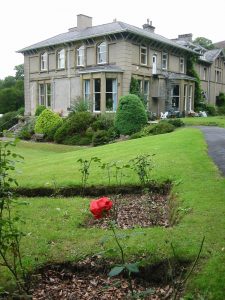 I have never seen so many wild primroses, got too hot in April by the sea in the UK, been blessed in water from 6th century St Seiriol’s Well and seen a circle of yew trees nearly 3,000 years old!
I have never seen so many wild primroses, got too hot in April by the sea in the UK, been blessed in water from 6th century St Seiriol’s Well and seen a circle of yew trees nearly 3,000 years old!
I was staying at Noddfa, a retreat centre in North Wales which I visit every year. I was on a pilgrimage following some of the Celtic saints in the area. We were mostly older people, helping each other down stone steps and up a steep Bronze Age grass burial mound where, “latterly” (i.e. over a 1000 years ago), some of the Celtic saints are also buried. As I get older I find it important to try and learn new things and be invigorated, as creation around us is growing and renewing after the winter.
We began and ended each day with Celtic prayer and music. We read about the “living water” that Jesus spoke of to the Samaritan woman at the well (Jn.4:10). Then we went to Anglesey to Penmon Priory, to the Well, Spring and 6th century stone outline of St Seiriol’s Cell. He was a hermit but people flocked to him to be blessed and healed in the water from the Well. There is an enclosed stone platform around clear water, and this was where I saw thousands of primroses in the grave yard of the mediaeval priory built by the Well.
Another day we went to Gwytherin, the site of St Winefride’s (Gwenffrewi), 7th century burial place. She was associated with Holywell, near Flint, where many visit. It is known as the Lourdes of Wales. We did not go there but to the site of the monastery where she lived and in a monastic community.There are four yew trees at the place, nearly 3,000 years old which probably were planted by Druids for their gatherings. The Christians later moved on to the site. Under the current church was the wooden monastic community where St Winefride and others lived, next to the ancient burial mound. It had a wooden church on top of the Bronze Age mound in Winefride’s day.
There is no longer evidence of these wooden structures. St Winefride’s body was supposedly removed to Shrewsbury by a monk in the 12th century. Did he? Is she still there? The other Saints remain. But for the Celtic Christians, for me and others on the Pilgrimage, it isn’t so much about the testable evidence, but a spirit, and energy, the history, a “knowing” at these holy places… I think older people with life experience, and a long relationship with God and other people, can pray and “know” some of the infinite aspects of God and the Saints, in the mystical tradition espoused by Richard Rohr, Joan Chittister and many others. I visited a number of sites where Celtic Saints have lived, and where they have healed and baptised in springs and wells in places which have been centres of pilgrimage for over a 1,000 years, there is a presence and a knowing that we experienced, shared and take back to our homes and parishes. I feel invigorated with learning and experiencing some new ways of living my faith. Happy Spring time to all!
Pippa Bonner – wife, daughter, mother and grandmother, writer and trustee
